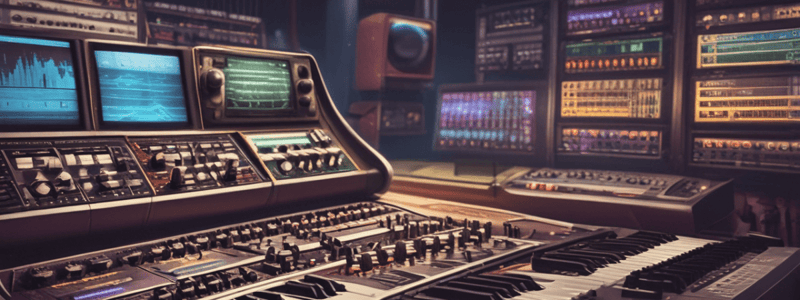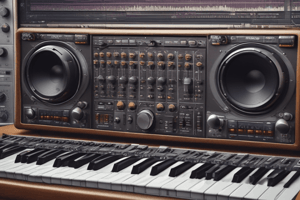Podcast
Questions and Answers
What determines the system's performance in Pro Tools?
What determines the system's performance in Pro Tools?
- The Setup menu
- The Playback Engine dialog box (correct)
- The Device section
- The I/O Setup dialog box
How do you change the playback device in Pro Tools?
How do you change the playback device in Pro Tools?
- From the Setup menu, choose Playback Engine (correct)
- From the View menu, choose Window
- From the File menu, choose New Session
- From the Edit menu, choose Preferences
What happens when you change the playback device in Pro Tools?
What happens when you change the playback device in Pro Tools?
- Pro Tools will close and require a relaunch
- The session will remain open and unchanged
- Either option A or option B, depending on the device (correct)
- Pro Tools will restart automatically
Where do you manage the I/O configuration after changing the playback device?
Where do you manage the I/O configuration after changing the playback device?
What is the result of changing the playback device in Pro Tools?
What is the result of changing the playback device in Pro Tools?
What is the purpose of the Playback Engine dialog box?
What is the purpose of the Playback Engine dialog box?
What is the primary function of a hardware buffer in Pro Tools?
What is the primary function of a hardware buffer in Pro Tools?
Which hardware buffer domain is used for tracks with live inputs?
Which hardware buffer domain is used for tracks with live inputs?
What is the default setting for the High Latency Hardware Buffer?
What is the default setting for the High Latency Hardware Buffer?
Why might you need to increase the hardware buffer setting when recording a large number of tracks?
Why might you need to increase the hardware buffer setting when recording a large number of tracks?
What is the purpose of the Ignore Errors During Playback/Record option in the Playback Engine dialog box?
What is the purpose of the Ignore Errors During Playback/Record option in the Playback Engine dialog box?
Why might you need to deactivate or freeze Virtual Instrument tracks in a session?
Why might you need to deactivate or freeze Virtual Instrument tracks in a session?
What happens when you import video into a Pro Tools session?
What happens when you import video into a Pro Tools session?
What is the benefit of keeping the hardware buffer setting low in Pro Tools?
What is the benefit of keeping the hardware buffer setting low in Pro Tools?
Why might you need to increase the hardware buffer setting when using plug-in effects on Auxiliary Input tracks?
Why might you need to increase the hardware buffer setting when using plug-in effects on Auxiliary Input tracks?
What is the purpose of the Track Freeze feature in Pro Tools?
What is the purpose of the Track Freeze feature in Pro Tools?
What is the main risk of enabling Ignore Errors During Playback/Record?
What is the main risk of enabling Ignore Errors During Playback/Record?
When is it recommended to enable Ignore Errors During Playback/Record?
When is it recommended to enable Ignore Errors During Playback/Record?
What is the purpose of Minimize Additional I/O Latency?
What is the purpose of Minimize Additional I/O Latency?
What is the benefit of Dynamic Plug-in Processing?
What is the benefit of Dynamic Plug-in Processing?
When should you disable Optimize Performance at Low Buffer Sizes?
When should you disable Optimize Performance at Low Buffer Sizes?
What is the purpose of Limit Number of Real-Time Threads?
What is the purpose of Limit Number of Real-Time Threads?
What is the main consideration for enabling Intel Turbo Boost?
What is the main consideration for enabling Intel Turbo Boost?
What is the purpose of Disk Playback?
What is the purpose of Disk Playback?
When should you disable Limit Number of Real-Time Threads?
When should you disable Limit Number of Real-Time Threads?
What is the main benefit of enabling Dynamic Plug-in Processing?
What is the main benefit of enabling Dynamic Plug-in Processing?
What is the primary function of the Pro Tools Aggregate I/O device?
What is the primary function of the Pro Tools Aggregate I/O device?
What is the alternative driver option for Windows computers that do not have WASAPI or ASIO drivers?
What is the alternative driver option for Windows computers that do not have WASAPI or ASIO drivers?
What is the result of clicking the Launch Setup App in the Hardware Setup dialog box?
What is the result of clicking the Launch Setup App in the Hardware Setup dialog box?
What is the similarity between the Pro Tools Aggregate I/O on Mac and the option on Windows?
What is the similarity between the Pro Tools Aggregate I/O on Mac and the option on Windows?
What is the limitation of the Pro Tools Aggregate I/O device on Mac?
What is the limitation of the Pro Tools Aggregate I/O device on Mac?
What is the primary advantage of using a fixed cache size in Pro Tools?
What is the primary advantage of using a fixed cache size in Pro Tools?
What is the purpose of the Disk Playback Cache Size pop-up menu?
What is the purpose of the Disk Playback Cache Size pop-up menu?
What happens when you choose a fixed cache size in Pro Tools?
What happens when you choose a fixed cache size in Pro Tools?
How is the amount of RAM available for audio file caching determined?
How is the amount of RAM available for audio file caching determined?
What is the recommended approach when prioritizing the use of RAM for plug-in processing?
What is the recommended approach when prioritizing the use of RAM for plug-in processing?
What is the System Usage window used for?
What is the System Usage window used for?
What is the Hardware Setup dialog box used for?
What is the Hardware Setup dialog box used for?
What is the advantage of using a computer's built-in I/O?
What is the advantage of using a computer's built-in I/O?
What is the Pro Tools Aggregate I/O?
What is the Pro Tools Aggregate I/O?
What determines the options available in the Hardware Setup dialog box?
What determines the options available in the Hardware Setup dialog box?
Study Notes
Playback Engine Dialog Box
- The Playback Engine dialog box determines a system's performance and can be adjusted to accommodate various workflows.
- It allows changing the playback device to fit specific needs.
- The process of changing devices is similar to choosing an initial device: select the desired device in the Playback Engine pop-up menu.
- Changing devices affects input and output (I/O) configuration, managed in the I/O Setup dialog box.
Hardware Buffer Size
- A buffer is an allocated amount of computer memory for temporary data storage to ensure stable performance.
- Pro Tools has two hardware buffers: Low Latency and High Latency.
- The Low Latency Hardware Buffer applies to tracks with live inputs (e.g., record-armed audio tracks).
- The High Latency Hardware Buffer applies to tracks without live inputs (e.g., playing back audio).
Choosing the Best Hardware Buffer Setting
- There is no single best setting for the Hardware Buffer.
- A low buffer setting provides low recording latency, but factors like plug-in effects, recording tracks, and virtual instruments may require higher buffer settings.
Video Engine
- The Video Engine enables or disables the Avid Video Engine (AVE).
- Enable it only when needed, as it consumes system memory.
Ignore Errors During Playback/Record
- This setting suppresses errors related to processing, but may compromise audio quality.
- Enable it only when necessary, and disable it when recording or creating a final mix.
Minimize Additional I/O Latency
- Available when Ignore Errors During Playback/Record is enabled.
- Limits the amount of latency needed to its minimum value (128 samples).
Dynamic Plug-in Processing
- Introduced in Pro Tools version 11, it only draws CPU power for plug-ins when there is audio to be processed.
- Enable this feature for a boost in processing power.
Optimize Performance at Low Buffer Sizes
- Improves CPU performance at small Hardware Buffer settings.
- Enable it, except in cases where certain plug-in effects cause system hangs.
Limit Number of Real-Time Threads
- Applies only to Intel-based Mac computer systems.
- Enable it to resolve conflicts with other applications using real-time threads.
- Disable it when recording if possible.
Intel Turbo Boost
- Available on Intel-based Mac systems with Turbo Boost support.
- Enables the CPU to accelerate beyond its rated frequency, but may cause fan noise.
- Enable it, but disable if fan noise becomes a problem.
Disk Playback
- Copies audio from storage into RAM for playback, optimizing system performance.
- Allows multiple interfaces to be used simultaneously.
Hardware Setup Dialog Box
- Configures and monitors system performance.
- Options vary based on attached hardware.
- Accesses device settings and proprietary software.
Using a Computer's Built-In I/O
- Convenient for producing on the go with a laptop computer.
- Process differs between Mac and Windows-based computers.
Studying That Suits You
Use AI to generate personalized quizzes and flashcards to suit your learning preferences.





